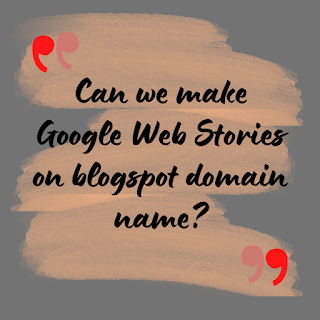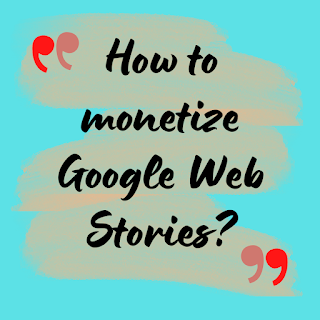How to create Google Web Stories and some FAQs
Web stories are a visually rich, full-screen content format for the web that allow you to tap or swipe through stories. In Google search and Discover, you might find web stories across web pages. Web story is still a web page. Just as any web page requires high-quality content in order to be useful and interesting, providing a complete narrative and following storytelling best practices are essential for creating web stories that drive engagement. In this blog post, we'll go over the basics of creating web stories, plus provide formatting and design tips, tools you can use to enhance your story, and advice on how to write web stories that engage your audience.
What is a Web Story?
Web stories are a great way to engage readers and build a connection with them. They are interactive formats that use storytelling to engage readers. Storytelling often involves dialogues, which make the reader feel like they are part of the story. You can create web stories in a variety of ways, but following best practices will help you achieve the most effective results. For example, make sure your stories are well-written and easy to understand. Also, make sure to include images, videos and other multimedia content to make them more engaging. Finally, make sure your stories are based on real-life experiences and elicit a reaction from your readers. By following these best practices, you'll ensure that your web stories are both engaging and effective in driving engagement.
How to Create a Web Story?
Storytelling is a powerful tool that can help you build relationships with your audience and drive traffic back to your website. A web story is a story that is told on a website and is a great way to tell a story that is relevant to your brand. As a web story creator, make sure the design of the story page reflects the tone and style of your story, so people will understand what they're getting into when they click through. Additionally, make sure the story is well-written, engaging, and visually appealing. In short, a web story is a great way to tell a story that can help your website and content stand out from the competition.
Can we create Google Web Stories on mobile?
Yes, we can make web stories on mobile by using visual stories app.
Can we make Google Web Stories on blogspot domain name?
The Benefits of Creating Web Stories
Web stories are a powerful marketing tool that can help you engage your audience and promote your brand. By following the best practices for web storytelling, you can improve engagement rates significantly. This means stories that are well-executed lead to more clicks and conversions - making them highly effective marketing tools! Web stories are easy to create and share, so you can get started right away. So, what are you waiting for? Get creative and start storytelling like a pro!
Formatting and Design Tips for Web Stories
When it comes to web stories, a clear story structure and well-designed formatting and design are key. This can help readers follow the story easily and make sense of the information being presented. To help you with this, make use of effective formatting and design techniques. For example, use paragraphs and headings to organize your story, and use images and videos to enhance your content. Additionally, make use of interactivity and feedback to keep readers engaged. For example, add quizzes or polls to stories to gather feedback and data. Use web analytics tools to measure the success of your web stories. This will help you improve and tweak your content as needed. So, if you're looking to create engaging web stories that drive engagement, follow these best practices!
How to monetize Google Web Stories?
How much you can earn from Google Web Stories?
How to Format Your Web Stories
Creating web stories that drive engagement is a skill that takes time and practice. But the rewards are definitely worth it. Here are a few best practices that will help you achieve success:
When writing web stories, it’s important to follow a consistent format to ensure your readers can follow your story easily. Here are some tips to help you format your web stories:
1. Start each paragraph with a capital letter.
2. Use a consistent font size and typeface throughout your story.
3. Use numbered paragraphs to help readers follow your story.
4. Use headings to organize your story content.
5. Use quotes to add suspense, intrigue, or to highlight key points in your story.
6. Use images to add visual interest to your story.
7. Use hyperlinks.
Tools You Can Use to Enhance Your Web Story
Web stories are a great way to engage readers and drive conversions. However, to achieve the best results, you need to use the right tools and techniques. One of the best tools you can use is videos. Not only do they provide a visual story-telling experience, but they can also be personalized with your own voice. Additionally, social media is a great way to share web stories with the world. Utilize Facebook, Twitter, and other social media channels to get the word out there. Use interactive elements to drive storytelling forward and make readers feel like they're a part of the story. Additionally, photos can be a great way to add a touch of personalization and humanize your web story. By using these tools and techniques, you'll be on your way to creating web stories that drive engagement and conversions!
Frequently Asked Questions
What are the three best practices for writing web stories that drive engagement?
To write web stories that engage readers, you should keep the following in mind: 1. Add videos, GIFs and images that will help engage readers and keep them coming back for more. Images and videos can spark curiosity and make your web stories more interesting to read. 2. Make your web stories interactive by asking questions or providing prompts for the user to follow. This will make your web stories more engaging and help followers learn more about the topic you're writing about. 3. Write in a fast pace with easy to read language so that everyone can understand what you're saying. This will help make your web stories easier to read and allow more people to learn from them.
What are some of the best methods for promoting my web stories?
Promoting a web story through social media, e-mail marketing, and blog syndication can all be effective methods for increasing engagement and generating leads for your business. Social media is the most popular method of promoting web stories; by using platforms like Facebook, Twitter, and LinkedIn, you can reach a wide range of people who might be interested in what you have to say. Mailing lists are another great way to market your web stories to a large audience. By creating a list of subscribers who you think would enjoy your content, you can send them periodic updates about new stories and content. Lastly, blog syndication is a great way to get your web stories in front of a wider audience. By sharing your stories on various influential blog sites, you can help to increase visibility and reach for your content. Measuring the success of a web story is simple - simply look at how engaged the readers are with the story and how many interactions it has generated. If you see positive engagement rates and high levels of interaction from readers, then you can be sure that your web story was a success.
How do I create a story that is memorable and engaging?
Creating a story that is memorable and engaging is all about hitting all the right buttons. To do this, make sure your blog post is well-written and catchy. This will help keep readers hooked until the end. Next, try out different storytelling techniques like cliffhangers, ladders, and mirrors. These will help to keep readers intrigued until the story reaches its conclusion. In addition to catchy writing, images, videos, and quotes can also add flavor and interest to your story. Try incorporating different visuals (such as photos, screenshots, or illustrations) to help draw readers in. And make sure to stick to the main point of your story while weaving in other details that are relevant. This will ensure that your readers understand what you're trying to say without feeling bogged down by irrelevant information.
How can I measure the success of my web storytelling efforts?
To measure the success of your web storytelling efforts, you first need to be transparent about how you're driving engagement and be sure to credit any sources you use (including images). Secondly, you need to create engaging stories that drive traffic. This means that you're thinking about what engages your reader on a personal level and incorporating it into your web storytelling strategy. Lastly, you should measure engagement through three key factors: Shares, Comments, and Likes. For Shares, think about how many times your story was shared on social media or elsewhere online. For Comments, see how many people have engaged in a conversation about your story by writing comments or leaving feedback. And for Likes, see how many people have clicked on a story's like button.










0 Comments